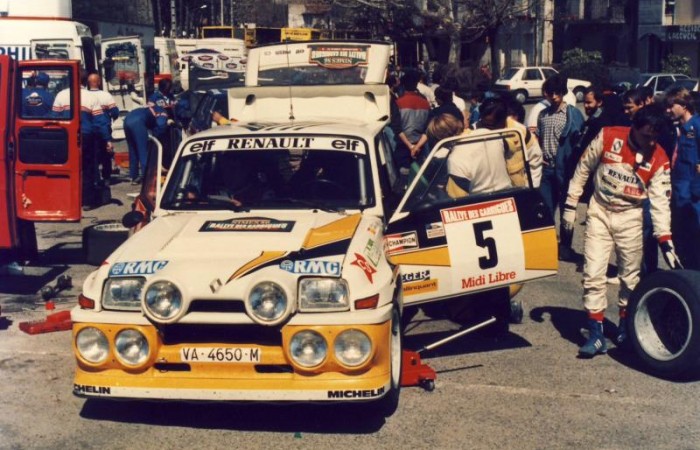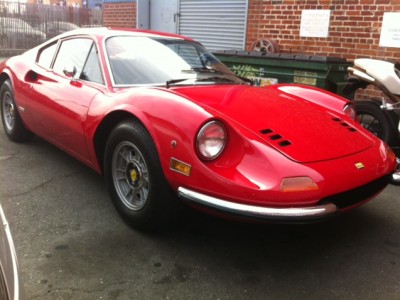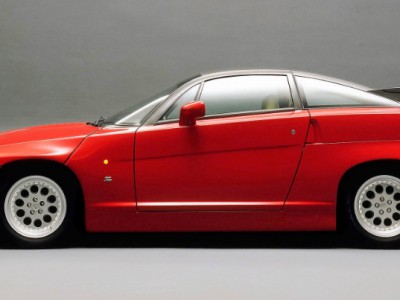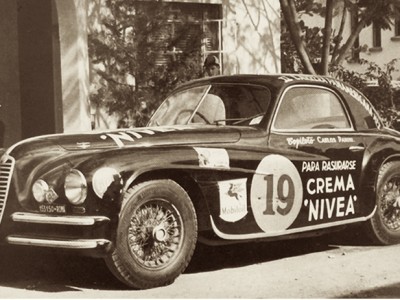Details
- SOLD
- Body Type: Coupe , Sports
- Dealer Location: Madrid
- Engine Size: 1.5L
- Trans: Manual
- Fuel Type: Gas
It was in 1984 when Renault showed the latest evolution of the Tour de Corse, which would be the most impressive, aggressive but at the same time elegant, called Renault 5 Maxi Turbo. The Maxi Turbo incorporated a new engine, from 1397 cc to 1527 cc thanks to the incorporation of new cylinder dimensions. These were 77 mm instead of 76 mm, as in the 1.4 liters engine, and a new crankshaft that increased the race from 77 to 82mm. This configuration was adopted to offer the maximum torque at the lowest possible turn rate. The K Jetronic injection from Bosch was coupled with an electronic control system by Renault Sport. The Turbo was no longer a Garrett T3 but a Garrett T3 / T4 designed for a boost pressure that can vary between 1.6 and 1.85 bar (with control from the cockpit). The boost pressure can thus reach 2.85 bar. The engine with this configuration offered 350 hp at 6500 rpm and a torque of 43 mkg at 4000 rpm.
Renault Sport ordered to manufacture a water / water intercooler to cool the compressed air. This was placed in the front part adjacent to the water radiator. The front axle was equipped with reinforced ball joints, variable flexibility helical spring, Bilstein gas damper and wheel tracks with 80mm raceways to cool the discs. The admission had a water injection system that improved cooling. The crankcase was of the dry type, the pistons forged and, like the exhaust valves, were cooled by oil. The ignition was electronic cartographic type of the manufacturer Magneti Marelli model Microplex.
The empty weight of the Renault 5 Maxi Turbo was 905kg and its power to weight ratio was 2.58kg / hp. The clutch and box cases were built in magnesium, with a design that facilitated rapid interventions in rallies. The gears had been reinforced, the bearings were special and the conical pair of greater diameter. There were three possible differential ratios: 9×35, 8×35 and 9×31. The slip differential, usually used to be regulated at 45%. The oil of the gearbox was cooled by a circuit comprising an electric pump with thermostatic regulation and an aluminum radiator. The deposit was 100 liters made with elastic material and the baquets were made of carbon fiber.
The shell was made of steel with the roof and doors in aluminum, while the flenders, the tailgate, the bumpers, hood and the full wheel arches were made in kevlar-carbon. Thus the Maxi Turbo achieved 30% more rigidity.
Regarding the suspension, a new design was used, with higher capacity ball joints, a steering rack mounted much more rigid, stabilizer bars controlled by ball joints, coil springs with two adjustment levels. The gas shock absorbers were Bilstein with the progressive stops made by Kleber. For braking, (adjustable from the passenger compartment), the same assembly as before, with ventilated discs of 276.6 mm. of diameter by 26.1 mm of thickness and four piston calipers of 38 mm of diameter. The hand brake was hydraulic.
The Maxi was equipped with 8×15 front and 11×15 rear wheels instead of 7×15 and 9×16.5 in the Tour de Corse version. To the left of the steering wheel, four small water temperature clocks, oil pressure, oil temperature and battery charge. On the sides of the steering column, the speedometer and the revs counter and again a group of four watches, of which two had been disabled and others for the level of gasoline. Further to the right you can see the pressure clock of the gasoline pump and the supercharging pressure and very close to it, the famous hand that allowed to play with the calibration of the waste gate and therefore with the supercharging pressure.
Above the boost pressure gage, there was the light which indicated that the water injection was working correctly (from 2.2 bar) and a small digital display that showed the temperature of the intake air (usually over the 30º C) Among these lights, we could see next to the revs-counter a light that showed to the driver the non-functioning of the water injection and a water temperature light for the gearbox.
The car, during the Group B era, won its first rally in 1985, year and rally of its debut, more precisely at the Tour de Corse rally, which was part of the World Rally Championship. Despite the multitude of legends, only 20 units of Renault 5 Maxi Turbo were officially manufactured, of which 11 were assigned to competition and the other 9 as spare parts. Some of these units originally intended to be for spare parts, were assembled after the abolition of the so called “Group B” era.
The two units that FASA Renault owned, were driven by Carlos Sainz during the group B era.
At the time, import vehicles needing registraron in Spain, were given a provisional red number late called “primer semestre” (first semester), if the final documentation was not ready yet by the end of that semester, an extension of temporary registration called “segundo semestre” (second semester) could be requested, (which are the red ones that had initially Carlos Sainz). At the end of 1985, he was given the definitive and white permanent registration plate VA-4650-M, which was issued in Valladolid (VA=Valladolid), headquarters of the FASA Renault factory in Spain.
Palmares of this unit:
1985 (Carlos Sainz Renault 5 Maxi Turbo RWD)
Spain National Rally Championship – 2nd Overol (Painted in Renault official works colors)
Points 1449
5th at Rally RACE
2nd at Rally Carles de Parafrugel
2nd at Rally Sierra Morena
1st at Rally Vasco Navarro
1st at Rally El Corte Ingles
1st at Rally Islas Canarias
2nd at Rally Princesa de Asturias
3rd at Rally Valeo Madrid
1986 (Carlos Sainz Renault 5 Maxi Turbo RWD)
Spain National Rally Championship – 2nd Overol (Painted in Renault official works colors)
Points 1286
2nd at Rally Costa Brava
1st at Rally El Corte Ingles
1st at Rally Islas Canarias
2nd at Rally Princesa de Asturias
2nd at Rally de Cataluña
1st at Rally Valeo Madrid
1988 (Guillermo Barreras Renault 5 Maxi Turbo 4X4)
Spain National Gravel Championship− 4th overall (Painted in blue Phillips livery) This year Guillermo participanted the first two rallys with a Renault 11 Turbo so he didn’t have any options against the Delta S4 of Trelles.
Points − 97
2nd at Rally RACE-Madrid MAD
8th at Rally RACE-Lloret de Mar LLM
2nd at Rally RACE-Toledo VLL
3rd at Rally RACE Avilés
5th at Rally RACE-La Rioja
1989 (Guillermo Barreras Renault 5 Maxi Turbo 4X4)
Spain National Gravel Championship- 2nd overall (painted in red Phillips livery) right behind a Delta S4 Gr B of Trelles
Points 132
2nd at Rally de Córdoba
2nd at Rally de Toledo
4th at Rally Ciudad de Lugo de Tierra
1st at Rallye RACE-Avilés
2nd at Rally RACE-Costa Cálida
2nd at Rallye Camel – Lloret de Mar
Retired at Rallye de Portugal – Vinho do Porto
After the group B category was abolished, these vehicles were practically in disuse, being mostly targeted to gravel championships, as it was the case of this unit. The entire Maxi Turbo competition team was assigned to its new official driver Guillermo Barreras. The Sainz’s Maxi was then converted to 4WD to compete in the Spanish gravel championship against Deltas S4, 205 T16, Metro 6R4, etc.… carrying always the mythical license plate ex Sainz VA-4650-M. Sainz and Guillermo Barreras, as official Renault drivers, achieved the results mentioned above. In 1985 and 1986 Sainz would carry the Renault official livery colors in yellow, black and white, in 1988 Barreras competed with Phillips livery painted in blue and in 1989 with Phillips livery painted in red.
At the end of this successful period in the Spanish Rally Championships, a Sainz “muletto” was sold abroad without documentation. Later, this main unit that Barreras inherited from Sainz, was disassembled by the factory.
Renault Spain completed the totaly front dammaged shell that Sainz crashed at the San Froilan rally. That shell was cut in almost half and welded to an used front Renault 5 shell and they accomodated some Sainz mechanics and sold abroad without papers, leaving the authentic Sainz / Barreras’s shell in Spain. None of the units sold abroad had any documentation, being sold practically as “Mulettos”. The only documented car was the one which remained in Spain.
After several dormant years in Spain, the vehicle was fully completed and restored in a way to strictly preserve its most meticulous originality. During the restoration process, we have emphasised in letting seen the traces left by the history, which means, all the work done at the time for the transformation to 4WD, transmission hole from the gearbox to the front differential, the spots left by the stones in the wheel passes during its gravel period, the original Matter roll cage showing their original aluminium identification plates, its original body number and some original body parts in Carbon-Kevlar still with the decoration of Carlos Sainz and Guillermo Barreras.
As previously mentioned, the vehicle has been reconverted to Group B in its original rear wheel drive version, carrying its original magnesium gearbox, its original magnesium speedline wheels (which still had the “E” on then for “España” which represented the Spanish team), original EF-4 type Renault Sport engine block for the few Maxi Turbos built, its original crankshaft and pistons with lubrication cavity, its original suspensions and brakes with magnesium calipers, its waste gate, DPV type formula 1, original Cibiè lights, original turbo and manifolds, original water injection, original Kugelfisher injection, original Magneti Marelli control system, original ¨black boxk¨control system for the fuel injection, original water pump, etc … and is up-to-date with its original documentation, registered with its license plate VA-4650-M.
This unit was the first Maxi ever built and, the proof of it is its unique VIN number, which starts with the letters “PT”, which means “prototype” and ends with the number 1 for the first unit. As it was a one-off vehicle back then in Spain, not existing administratively in the récords of the spanish traffic department, it needed an individual homologation and therefore the denomination for this Maxi Turbo,was administratively registered as “Renault 5 Turbo Special”.
En 1984 era cuando Renault mostraba la última evolución del Tour de Corse, la que seria absoluta y definitiva, llamada Renault 5 Maxi Turbo. El Maxi Turbo incorporó un nuevo motor, pasando de los 1397 cc a los 1527 cc gracias a la incorporación de nuevos cilindros, estos eran de 77 mm y no de 76 mm como el del 1.4 y de un nuevo cigüeñal que aumento la carrera de 77 a 82 mm. Esta configuración se adoptó para ofrecer el máximo par al régimen de vueltas más bajo posible. A la inyección K Jetronic de Bosch se acopló un sistema de regulación electrónica de Renault Sport. El Turbo ya no era un Garrett T3 sino un Garrett T3/T4 previsto para una presión de sobrealimentación que puede variar entre 1,6 y 1,85 bar (con mando de regulación desde el puesto de pilotaje). La presión de sobrealimentación puede llegar así a 2,85 bar. El motor con esta configuración ofrecía 350 cv a 6500 rpm y un par de 43 mkg a 4000 rpm.
Renault Sport mando fabricar un intercooler agua/agua para refrigerar el aire comprimido. Este se situó en la parte delantera colindante al radiador de agua. El tren delantero, estaba equipado con rótulas reforzadas, muelle helicoidal de flexibilidad variable, amortiguador de gas Bilstein y pasos de ruedas con canalizaciones de 80mm para refrigerar los discos. La admisión contaba con un sistema de inyección de agua que mejoraba la refrigeración. El cárter era de tipo seco, los pistones forjados y al igual que las válvulas de escapes, estaban refrigerados por aceite. El encendido era de tipo electrónico cartográfico del fabricante Magneti Marelli modelo Microplex.
El peso en vacío del Renault 5 Maxi Turbo era de 905kg y su relación peso potencia de 2,58kg/cv. Los cárteres de embrague y de caja se construyeron en magnesio, con un diseño que facilitaba las intervenciones rápidas en rallyes. La piñonería había sido reforzada, los rodamientos eran especiales y el par cónico de mayor diámetro. Había tres relaciones de puente posibles: 9×35, 8×35 y 9×31. El diferencial autoblocante, de disco, solía generalmente estar regulado al 45 % y que el aceite del conjunto caja-puente, estaba refrigerado por un circuito que comprendía una bomba eléctrica con regulación termostática y un radiador de aluminio. El depósito era de 100 litros fabricado con material elástico y los baquets eran de fibra de carbono.
El casco estaba fabricado en acero con el techo y puertas de aluminio, mientras que las aletas, el portón trasero, los parachoques y el carenado integral de los bajos, era de kevlar-carbono . Así el Maxi Turbo logró un 30% más de rigidez.
Respecto a la suspensión, se utilizaba un nuevo diseño, con rótulas de mayor capacidad, una cremallera de dirección montada de forma mucho más rígida, barras estabilizadoras mandadas por rótulas, muelles helicoidales con dos niveles de flexibilidad, los amortiguadores de gas eran unos Bilstein y que los topes progresivos habían sido realizados por Kleber. Para el frenado, regulable desde el habitáculo, el mismo montaje delante que detrás, con discos ventilados de 276,6 mm. de diámetro por 26,1 mm de espesor y estribos de cuatro pistones de 38 mm de diámetro. El freno de mano era hidráulico.waste
El Maxi estaba equipado con llantas de 8×15 delante y 11×15 detrás en lugar de 7×15 y 9×16,5 en la versión Tour de Corse. A la izquierda del volante, cuatro pequeños relojes de temperatura de agua, presión de aceite, temperatura de aceite y carga de la batería. A los lados de la columna de dirección, el velocímetro y el cuentavueltas y de nuevo un grupo de cuatro relojes, de los que dos habían sido inutilizados y otros destinados al nivel de gasolina. Más a la derecha se puede observar el reloj de presión de la bomba de gasolina y la presión de sobrealimentación y muy cerca de esta última, la famosa manecilla que permitía jugar con el tarado de la válvula de descarga y por ello con la presión de sobrealimentación.
Encima del indicador de la presión de sobrealimentación estaba el testigo luminoso que indicaba que le inyección de agua estaba funcionando correctamente (a partir de 2,2 bar) y un pequeño reloj de lectura digital que daba la temperatura del aire de admisión (generalmente sobre los 30º C) Entre los testigos luminosos encontrábamos junto al cuenta-vueltas un testigo de no funcionamiento de la inyección de agua y un testigo de temperatura de agua de la caja de cambios.
El coche en el Grupo B ganó su primer rallye en 1985, año y rally de su debut, el Tour de Corse. A pesar de la multitud de leyendas, oficialmente solo se fabricaron 20 unidades de Renault 5 Maxi Turbo, de las cuales 11 se destinaron a competición y las otras 9 a repuestos. Algunas de estas unidades destinadas originariamente para piezas, fueron montadas tras la abolición de la categoría denominada “Grupo B”.
Las dos unidades que FASA Renault poseía las condujo Carlos Sainz a lo largo de su trayectoria deportiva con este vehículo.
En la época, los vehículos de importación se les daba una matrícula roja provisional denominada “primer semestre”, de no estar todavía la documentación definitiva, se solicitaba una ampliación de matrícula temporal denominada “segundo semestre”, (que son las rojas que llevaba inicialmente Carlos Sainz) y posteriormente se le adjudicaba una matrícula definitiva blanca, la cual se adjudicó en Valladolid, sede de la fábrica de Renault en España.
Palmarés de esta unidad:
1985 (Carlos Sainz Renault 5 Maxi Turbo RWD)
Spain tarmac rally championship – 2nd Overol (Painted in Renault official works colors)
Points 1449
5th at Rally RACE
2nd at Rally Carles de Parafrugel
2nd at Rally Sierra Morena
1st at Rally Vasco Navarro
1st at Rally El Corte Ingles
1st at Rally Islas Canarias
2nd at Rally Princesa de Asturias
3rd at Rally Valeo Madrid
1986 (Carlos Sainz Renault 5 Maxi Turbo RWD)
Spain tarmac rally championship – 2nd Overol (Painted in Renault official works colors)
Points 1286
2nd at Rally Costa Brava
1st at Rally El Corte Ingles
1st at Rally Islas Canarias
2nd at Rally Princesa de Asturias
2nd at Rally de Cataluña
1st at Rally Valeo Madrid
1988 (Guillermo Barreras Renault 5 Maxi Turbo 4X4)
Spain Gravel − 4th overall (Painted in blue Phillips livery) This year Guillermo participanted the first two rallys with a Renault 11 Turbo so he didn’t have any options against the Delta S4 of Trelles.
points − 97
2nd at Rally RACE-Madrid MAD
8th at Rally RACE-Lloret de Mar LLM
2nd at Rally RACE-Toledo VLL
3rd at Rally RACE Avilés
5th at Rally RACE-La Rioja
1989 (Guillermo Barreras Renault 5 Maxi Turbo 4X4)
Spain Gravel- 2nd overall (painted in red Phillips livery) right behind a Delta S4 Gr B of Trelles
Points 132
2nd at Rally de Córdoba
2nd at Rally de Toledo
4th at Rally Ciudad de Lugo de Tierra
1st at Rallye RACE-Avilés
2nd at Rally RACE-Costa Cálida
2nd at Rallye Camel – Lloret de Mar
Retired at Rallye de Portugal – Vinho do Porto
Tras quedar abolida la categoría de grupo B, estos vehículos quedaron prácticamente en desuso, siendo destinados en su mayoría a los campeonatos de tierra, tal y como fue el caso de esta unidad. Todo el equipo de competición de Maxi Turbo, fue destinada a la tierra con su piloto oficial Guillermo Barreras, la cual fue convertida en 4×4 para competir en el campeonato de España de tierra. Con esta unidad, la cual llevaba la mítica matrícula ex Sainz VA-4650-M. Sainz y Guillermo Barreras, como pilotos oficiales de Renault, cosecharon los resultados que se citan anteriormente. En 1985 y 1986 Sainz portaría la publicidad de colores oficiales Renault en amarillo, negro y blanco, en 1988 Barreras llevó la publicidad de Phillips pintada en azul y en 1989 la publicidad de Phillips en rojo.
Al finalizar su exitosa época en los campeonatos de asfalto, un muleto de Sainz fue vendido al extranjero sin documentación. Posteriormente, la principal y que heredó y con la cual compitió Guillermo Barreras, esta unidad, fue desmontada para completar una carrocería procedente del accidente que sufrió Sainz en el tramo de rally de San Froilan de 1985 y que tenía su parte frontal completamente destrozada. Esa carrocería fue cortada por la mitad y soldada y completa de mecánica fue vendida al extranjero, quedando la autentica de Sainz/Barreras en territorio español. Ninguna de las unidades vendidas en el extranjero poseían documentación alguna, siendo vendidas prácticamente como muletos. La única unidad documentada fue la que quedó en España.
Tras algunos años de letargo en España, el vehículo fue completado y restaurado, conservando su máxima y estricta originalidad. Durante la restauración hemos dejado que se aprecien las huellas que dejó la historia en el, es decir toda la obra realizada en la época para la transformación a 4X4, paso de transmisión desde la caja de cambios al diferencial delantero, los restos que dejaron las piedras en los pases de rueda, las barras originales Matter con su número de identificación original, su número de carrocería y algunos repuestos de carrocería originales en Carbono-Kevlar todavía con la decoración de Carlos Sainz y Guillermo Barreras.
El vehículo ha sido reconvertido a grupo B en su versión original, con propulsión trasera, su caja de cambios original de Renault sport en magnesio, sus ruedas originales speedline en magnesio (las cuales todavía traían la “E” que denominaba al equipo español), bloque original Renault Sport de Maxi Turbo, su cigüeñal y pistones originales con cavidad de engrasado helicoidal, su ¨caja negra¨original para regular la inyecciòn, su centralita original Magneti Marelli, su inyección de agua original, su bomba de agua original, sus suspensiones originales y frenos con pinzas en magnesio, su waste gate, DPV tipo formula 1, proyectores originales Cibiè, turbo y colectores originales, etc… y se encuentra al día con su documentación original, dado de alta con su matrícula de origen VA-4650-M y completamente restaurado.
Dicha unidad fue la primera construida y, muestra de ello es su número de chasis, el cual inicia con las letras “PT”, que significan “prototipo” y finaliza con el numero 1, de primera unidad. Al ser un vehículo, por aquel entonces único en España y no existir administrativamente en la jefatura de tráfico, necesitó hacerse una homologación individual para este Maxi Turbo, siendo el vehículo matriculado administrativamente como “Renault 5 Turbo Especial”.
We recommend the following videoclips:




